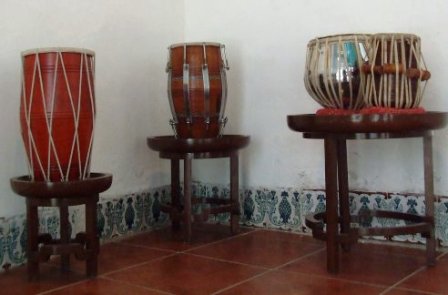Indian Musical Instruments in Cuba
By Yusimi Rodriguez, photos: Irina Echarry

HAVANA TIMES, May 15 — My plans for last Thursday afternoon consisted of going to a Vedado Cinema to see the movie “Fifty Dead Men,” starring Ben Kingsley. However, a few days prior I found out that at 3:00 that same afternoon an exhibition of traditional musical instruments of India was going to open at the Asia Museum here in Havana.
It was a difficult choice. On one hand there was the only showing of this movie based on a literary work and in which was performing one of my favorite actors; on the other hand was my interest in eastern philosophies and cultures, especially those of India, with its history, its traditions and its food.
Then too there was its music, which along with that country’s dance constitutes one of the most important elements and attractions in many of that country’s cinematographic productions, such as in the movie Lagaan, which I’ve seen four times.
Logic pointed to going to the cinema that afternoon and seeing the exhibition later, since it would be at the Asia Museum for the whole month of May. However, had I not gone to the opening I wouldn’t have found out that this exhibit commemorates two important anniversaries: the 50th annual celebration of the establishment of diplomat relations between Cuba and India, and the 149th birthday of Indian national poet Rabindranath Tagore, who is also the author of the words of that country’s national anthem.

Another interesting detail I found out during that opening was that Tagore, in addition to being a great poet, had deep musical knowledge and founded a school of music in India.
Once inside and among the instruments, I could appreciate flutes of different sizes and styles; the Sitar, an instrument of traditional strings; and the harmonium, an instrument possessing a sound similar to that of the accordion and which was introduced by the British during the colonization of northern India.
This center, located on Mercaderes St., in Old Havana, was founded 1997 with the aim of promoting the cultures of Asian countries through exhibitions, courses, conferences and workshops.
I visited this institution for the first time in 1999. It was here that I attended a conference on spiritual leader Jiddu Krishnamurti, a seminar on Yoga and another one on Mahatma Gandhi during the India Week, which took place in January of that year.
Coincidently, the very same day I attended the conference on Gandhi, they showed the movie about him on television that evening; in fact, it too starred Ben Kingsley.
In this facility exists the Rabindranath Tagore Specialized Library, and courses are taught on Hindi, Japanese and Persian languages.
Click on the tumbnails below to view all the photos in this gallery











Lagaan is an example of the best of Bollywood, AFAIC. And living in a country with a long experience of british imperial control, I have some not small understanding of the experiences and feelings of the protagonists in the movie, for that matter. (I know of Tagore as well; but deep into poetry I am not, sadly. I do know however that he met and discussed World matters with the likes of Einstein, etc.)
Has anyone in Cuba ever thought of doing latin/jazz music with indian instruments like the sitar and tablas..? It worked for the Beatles and their imitators..!
For that matter IMO, hatha yoga should be a basic national exercise form in socialist countries like Cuba.